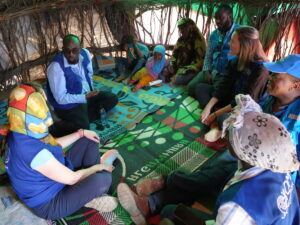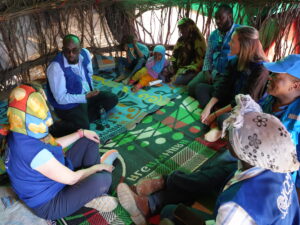10 Questions …. Kate Behncken, global head, Microsoft Philanthropies

Kate Behncken is corporate vice president, global head of Microsoft Philanthropies, a global, multi-disciplinary team that brings together corporate social responsibility, sales and engineering functions. She is focused on local and global initiatives, partnering with nonprofits, governments and the private sector to develop durable solutions and deliver impact at scale.
A good portion of her working life is traveling to see the implementation of Microsoft Philanthropies’ work.
You had at least several long days leading up to and after the recent inaugural Microsoft Nonprofit Global Leaders Summit and then you hopped a plane to Australia and New Zealand. That is a punishing schedule. What do you mix in to keep sane?
It’s certainly been an unusually busy start to the year, but energizing. I love getting out and about and meeting nonprofit partners and leaders around the world — the changemakers who are helping people and communities in so many different ways — and getting more local context.
It brings our mission to life and is also such an important listening system for us. That said, there are many days I need to stay sane and for me, it’s exercise and trying to get good sleep. Both can help refresh the mind.
Were you a tech person in your personal life prior to joining Microsoft?
Honestly, I was pretty naive about technology when I was much younger. Once I hit university and then started working, I could see how technology was developing fast and going to impact so many sectors in so many ways. And that’s why I wanted to work at Microsoft. Though I don’t think I could ever have predicted some of the incredible innovations we’re seeing today in this new era of AI. It’s mind-blowing.
You have described yourself as a recovering attorney. How did you come to philanthropy?
I was a lawyer for many years working for Microsoft in Australia and Europe and then had the opportunity to move to Redmond for a completely different role that grew into chief of staff for Brad Smith, Microsoft’s vice chair and president. This was a pivotal moment in my career. In that role I learned so much more about the social impact work of the company, and in fact, that’s when we incubated the TechSpark initiative which is now part of Microsoft Philanthropies. These experiences really lit the spark for me.
I have always had a passion for making a difference. I saw the incredible opportunities to create change when companies like Microsoft merge their mission-driven programs with their core expertise.
I confess a career in law never really lit me up like the work I do today.
Who are three people with no connection to Microsoft who you admire and why?
Amy Pope, Director General, IOM – UN Migration.
Amy Pope is the first woman to lead IOM in its 73-year history and she understands the critical role that technology can play in humanitarian work to drive efficiencies and more informed decision making that save precious dollars, time and ultimately lives.
Dr Fei-Fei Li, Professor and Co-Directo, Stanford’s Human Centered AI Institute
Dr. Fei-Fei Li stands out for her pioneering AI work and her commitment to making AI serve humanity. As co-director of Stanford’s Human-Centered AI Institute, she advocates for AI development that prioritizes human needs and diversity, ensuring technology reflects a wide range of perspectives. She also wrote a wonderful book “The World’s I See: Curiosity, Exploration, and Discovery at the Dawn of AI.”
Kelley Robinson, President, Human Rights Campaign
Kelley is the first Black, Queer woman to lead the Human Rights Campaign, a monumental role where she guides over 3 million advocates towards a fairer world for everyone. Her dedication to amplifying marginalized voices, paired with her vision for political empowerment, shows what it means to lead with purpose and passion.
Microsoft Philanthropies is a division of the company, not a tax-exempt organization. How are corporate goals aligned with philanthropy? What’s a thumbnail of the internal decision-making process?
Our company mission is to empower every person and every organization on the planet to achieve more. As a company, we succeed only when we help the world around us succeed. There is a fundamental belief that those of us that can do more, should do more. Philanthropy is really a part of the company’s DNA and Microsoft Philanthropies is a natural evolution of our corporate giving.
Our work is largely focused on empowering nonprofits and communities with digital and AI capabilities to expand opportunity for people around the world. So that’s the first filter. Then we think about the best ways to do this to ensure impact is both sustainable and scalable.
What percentage of the aid provided by Microsoft Philanthropies is technology in one form or another versus financial support for projects unrelated to tech infrastructure or products?
I really believe private sector can be most helpful when we stay close to our core strengths. In 2023, I was with IOM in a refugee camp in Northern Kenya where there were over 300,000 refugees escaping drought, persecution, and violence. Clearly, we are a technology company. We don’t have the expertise nor the resources to be first responders. This is why technology is and should be our major focus.
This year, we’ll provide over $3 billion in technology grants to more than 375,000 nonprofits around the world. Nonprofits and humanitarian organizations have used our technology to help serve over 1.2 billion beneficiaries around the world. This is where we see Microsoft Philanthropies’ greatest impact.
I am also proud to share our employees gave $250 million to over 35,000 nonprofits worldwide in 2023. As I said, a commitment to people and communities is in our DNA, and our employees continue to be incredibly generous and committed to making a difference.
A statistic cited by Microsoft President Brad Smith during the recent summit was startling — that between 700 million and 800 million people are still without electricity. Describe in your mind tech scalability in regions challenged by lack of basic resources.
It is a staggering number isn’t it. We focus on three things: internet connectivity, access to technology, and developing the skills needed to participate in the digital economy. Through partnerships with local and regional internet providers, energy access providers, telecom equipment makers, nonprofits, and governmental organizations, Microsoft’s AirBand initiative has already provided high-speed internet access to 80 million people globally and is set to expand its reach.
By the end of 2025, it aims to connect 250 million people in unserved and underserved communities worldwide, with a particular focus on connecting 100 million people in Africa. This effort underscores the importance of connectivity in fostering economic growth, education, and overall well-being on the continent.
Our Tech for Social Impact (TSI) business, a key part of Microsoft Philanthropies, aims to make state-of-the-art technology accessible and relevant for nonprofits tackling the world’s most critical issues. By integrating Microsoft’s commercial best practices across various domains with donations and discounts of our cloud and AI technologies, we serve over 350,000 nonprofits, driving social impact at scale.
But it’s more than just providing technology, it’s about actively working with these organizations to really use technology in a way that amplifies their work. This involves helping them innovate and digitally transform, with the support of our partners and resources aimed at building their tech skills and capabilities.
Even Microsoft can’t say “yes” to everything. Does that frustrate you when you simply can’t help?
We definitely can’t say yes to everything. We must stay focused and stick to our unique strengths to drive greater impact. And we must look for the partnerships where we can best complement what are the unique strengths of other organizations, so that we can do more together than we could all do alone.

Do you see the global south playing a more significant role for Microsoft Philanthropies in the future versus now?
As we look ahead, the potential for impactful collaboration and innovation in these regions is huge. Our focus is to empower these communities through technology access, skilling, and fostering innovation. Our approach is to work closely with local organizations, governments, and communities to understand their unique challenges and opportunities. Then we aim to support sustainable development that reflects the specific aspirations and needs in the region.
Take, for example, our collaboration with Amref, a leading nonprofit focused on global health based out of Kenya. Together, we’re equipping them with comprehensive digital capabilities, enabling community health workers to extend their reach and impact more lives. Another example of our engagement is our initiative with Peace Parks. We’re harnessing IoT sensors and AI to enhance conservation efforts, providing park rangers with advanced tools to protect wildlife.
It’s a Saturday morning and your tech (not a Microsoft product) has gone down so there’s no access to your schedule. What do you do with your day?
I’ve got two teenage boys with different sporting commitments every weekend so you can be sure there’s a chunk of the day where my schedule is spoken for. But on a blissful schedule free Saturday morning, I would have a good coffee, read the newspaper, do the crossword, the Wordle, the Nerdle, dig into a good book, have a few games of Splendor with my boys and a walk with my husband. As much as I appreciate technology in my day-to-day life, I also enjoy switching it off sometimes.
The post 10 Questions …. Kate Behncken, global head, Microsoft Philanthropies appeared first on The NonProfit Times.









Leave a Reply